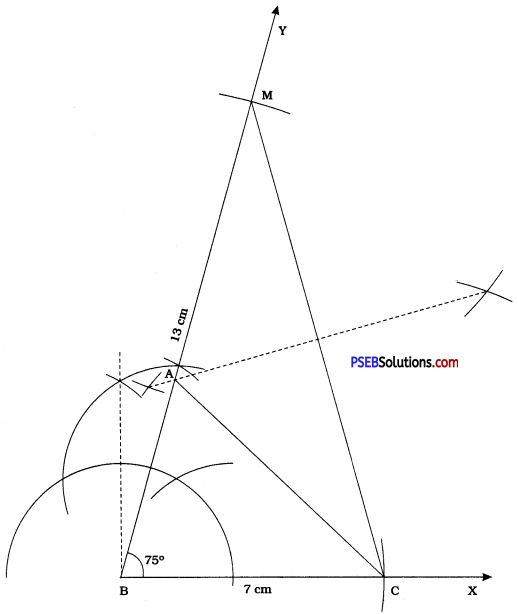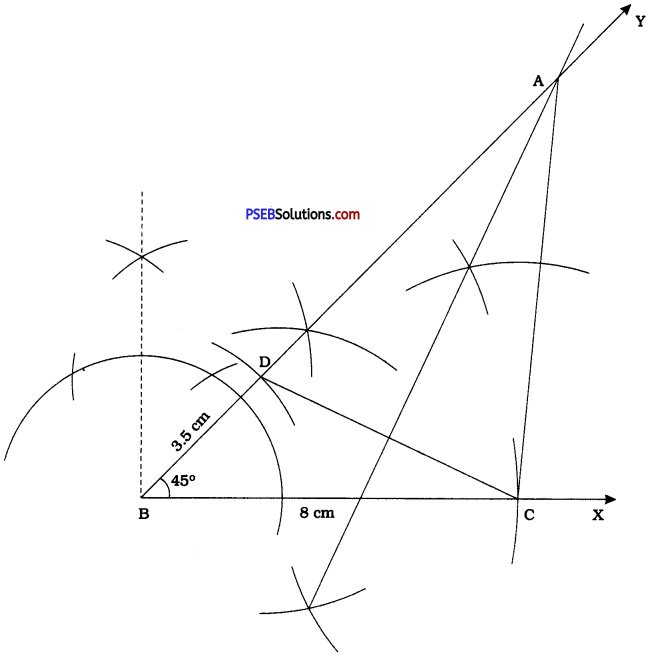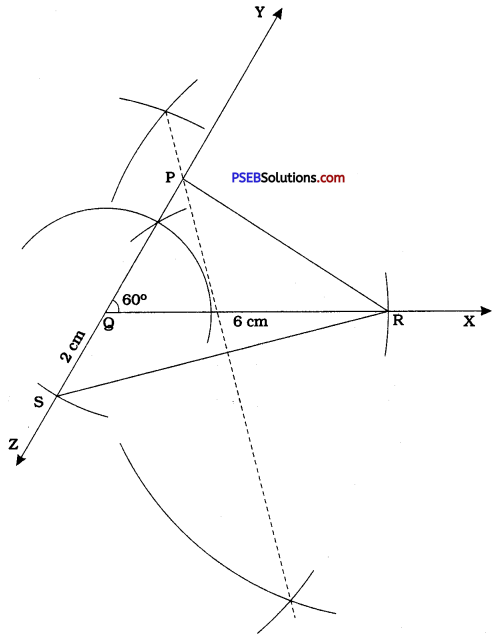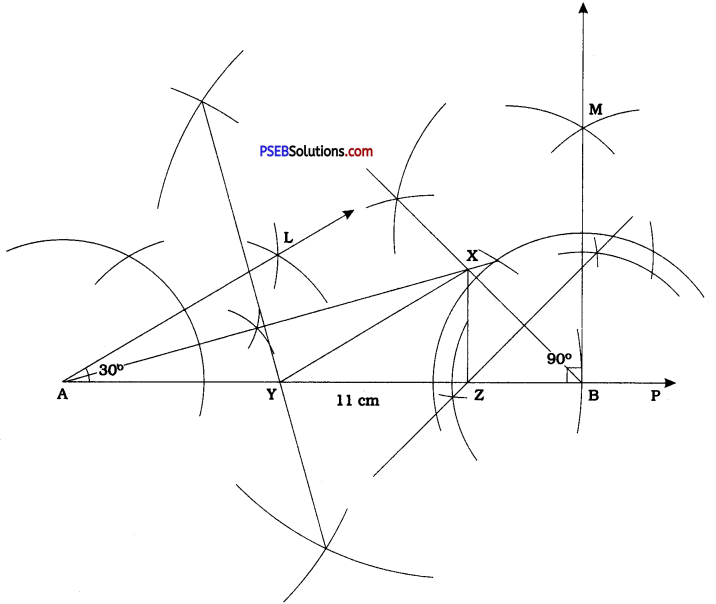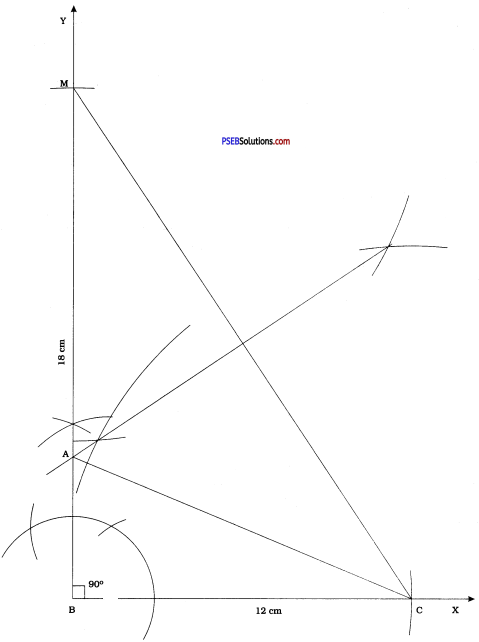Punjab State Board PSEB 9th Class English Book Solutions English Letter Writing Exercise Questions and Answers, Notes.
PSEB 9th Class English Letter Writing
Important Applications
Application For Marriage Leave
Suppose you are Gopal Singh. You are a student of IX-A class of A.S. High School, Khanna. Write an application to the Headmaster of your school for marriage leave.
Answer:
The Headmaster
A.S. High School
Khanna
Sir
I beg to say that my elder brother’s marriage takes place next week. I have much work to do. So I cannot come to school. Kindly grant me leave for five days. I shall be very thankful to you for this kindness.
Yours obediently
Gopal Singh
Roll No. 25
IX-A
15 March 20_ _.

Application For Leave
Due To Urgent Work
Suppose you are Gopal. You are a student of IX-A class of A.B. Sr. Sec. School, Ludhiana.You have an urgent piece of work at home. Write an application for leave to your Principal.
Answer:
The Principal
A.B. Sr. Sec. School
Ludhiana
Sir.
I beg to say that I have an urgent piece of work at home. So I cannot come to school. Kindly grant me leave for today. I shall be thankful to you for this kindness.
Yours obediently
Gopal
Roll No. 25
IX-A
5 March 20_ _.
Application For Remission Of Fine
Suppose you are Satish Kumar. You are a student of IX-B class of Govt. High School, Amritsar. Write an application to your Headmaster for the remission of fine.
Answer:
The Headmaster
Govt. High School.
Amritsar
Sir
Our English teacher gave us a test on Monday. That day, I was suffering from high fever. So I could not take the test. The teacher fined me ten rupees. I wanted to take the test, but couldn’t due to my illness. Kindly remit my fine and oblige.
Yours obediently
Satish Kumar
Roll No. 52
IX-B
5 February 20_ _.
Application For Full Fee-Concession
Suppose you are Sham Singh. You are a student of IX-B class of Govt. High School, Ludhiana. Write an application to the Headmaster of your school, requesting him to grant you full fee-concession.
Answer:
The Headmaster
Govt. High School !
Ludhiana
Sir
I am a student of IX-B of your school. My father is a peon. His pay is very small. He cannot pay my school fees. I am good at my studies. I am also a member of the Football Eleven. My teachers are pleased with me. I was a free student last year. Kindly grant me full fee-concession this year also. I shall be thankful to you for this kindness.
Yours obediently
Sham Singh
Roll. No. 25
IX-B
4 March 20_ _.

Application For School Leaving Certificate
Suppose you are Anil Kumar. You are a student of IX-E class of A.B.C. High School, Moga. Write an application to the Headmaster of your school to issue your school leaving certificate.
Answer:
The Headmaster
A.B.C. High School
Moga
Sir
I beg to say that I am a student of IX-E of your school. My father has been transferred to Shimla. My parents are leaving for Shimla next week. I cannot stay here alone. I am sorry to leave such a good school, but I can’t help it. My father has signed the application. Kindly issue me my school leaving certificate and oblige.
Yours obediently
Anil Kumar
Roll No. 32
IX-E
15 April 20_ _.
Application For Change Of Section
Suppose your name is Robin. You are a student of IX-B class of Guru Nanak Public School, Ludhiana. Write an application to the Principal of your school, requesting him to change your section.
Answer:
The Principal
Guru Nanak Public School
Ludhiana
Sir
I am a student of IX-B of your school. All my friends are in Section A of class IX. Some boys of IX-A live in our street. They can help me whenever I am unable to attend school. They can help me in other ways also. Kindly shift my name from IX-B to X-A and oblige.
Thanking you
Yours obediently
Robin
IX-B
15 March 20_ _.

Permission To Pay The Fees Late :
Suppose you are Charanjit Singh. You are a student of IX-A class of Govt. High School, Khanna. Write an application to the Headmaster of your school requesting him to permit you to pay your fees for the month late by ten days.
Answer:
The Headmaster
Govt. High School
Khanna
Sir
I beg to say that I am a student of IX-A of your school. Tomorrow is the fee day and I am unable to pay it. My father has gone to Delhi. He will come back in ten days. Kindly allow me to pay my fees late by ten days.
Thanking you
Yours obediently
Charanjit Singh
IX-A
9 March 20 – -.
Permission To Go On A Historical Tour
Suppose you are Pardeep Sikka. You are a student of Ix-B class of Govt. Senior Secondary School, Ludhiana. Write an application to your Principal, requesting him to permit your class to go on a historical tour.
Answer:
The Principal
Govt. Senior Secondary School
Ludhiana
Sir
Our school is closing for the summer vacation next week. We, the students of class IX, want to go on a historical tour. We want to see the Taj Mahal. We also want to see Fatehpur Sikri. On our way back, we want to go round Delhi also. The trip will be very useful for us as students of History. It will add to our knowledge. Kindly allow us and also help us to arrange this trip.
Yours obediently
Pardeep Sikka
(Monitor, Class IX-B)
9 March 20_ _.

Important Letter:
To Father For Money
Suppose you are Surjit Singh, living in the boarding house of your school. Write a letter to your father, requesting him to send you money to pay the examination fee.
Answer:
24 Boarding House
Arya High School
Nawan Shahar
2 February 20_ _.
47 Deep Nagar
Banga
My dear Father Our annual examination comes off in the month of March. We have filled in our admission forms. I have to deposit the examination fee. The last date is 15th February. I have also to pay the school fee. Please send me two hundred rupees. With love and respect to you and dear mother.
Yours affectionately
Surjit Singh
Invitation To Brother’s Marriage
Suppose you are Manish Kumar. You live at 35, Main Bazaar, Amritsar. Write a letter to your friend, inviting him to your brother’s marriage.
Answer:
35 Main Bazaar
Amritsar
4 March 20_ _.
45 Mall Road
Shimla
My Dear Kundan
You will be glad to know that the marriage of my elder brother comes off on March 19, 20_ _. The marriage party will leave for Delhi early in the morning that day. We shall stay in Delhi for two days. I want you to join the marriage party. You know that Delhi is a historical city. There are many buildings worth seeing. We will see the Red Fort, the Qutub Minar and the Jantar Mantar. Mohan and Sohan are also coming. They will reach here on Sunday. We will have good time together. I hope that you will reach in time.
Yours sincerely
Manish Kumar

Explaining The Cause Of Your Failure
Imagine you are Kishore. You live at 21, Model Town, Hoshiarpur. Write a letter to your father, explaining the cause of your failure and promising to do better in the Annual Examination.
Answer:
21 Model Town
Hoshiarpur
17 March 20_ _.
53 Malik Road
Patiala
My dear Father I am very sorry to inform you that I have failed in the last House Examination. I fail in English, Maths and Science. But believe me, father, I am not to blame for it. My failure is not due to any carelessness on my part. I put in hard work. But as ill luck would have it, I fell ill just before the examination. I had high fever. I could not revise my courses. So I was unable to do my papers well. Dear Father, I promise to do better in the Annual Examination. I request you not to mind my failure.
Your loving son
Kishore
To Father About Your Studies
Imagine you are Harinder Singh. You live in the boarding house. Your father wants to know . about your progress at school. Write a letter to him, telling him how you are getting on at school.
Answer:
Boarding House
D.A.V. School
Phagwara
15 March 20_ _.
157 Model Town
Amritsar
My dear Father I am very glad to receive your loving letter. You have asked me about how I am getting on at school. You will be glad to learn that I am quite happy here. I have made some good friends. They are hard-working and gentle. The warden of our hostel is very nice to me. I don’t feel lonely here. As for my studies, I am doing quite well. We are having a test next week. I hope to do very well in English and Mathematics. In other subjects, too, I am doing well. I take interest in games also. I have become a member of the hockey eleven. I attend the playground regularly.
With regards
Yours affectionately
Harinder Singh.

Advice To Take Part In Games
Suppose you are Varun. You live at 18, Shakti Nagar, Sangrur. Write a letter to your younger brother, scolding him for not taking part in games.
Answer:
18 Shakti Nagar
Sangrur
19 February 20 – -.
2 Nehru Market
Shimla
My dear Raman
I have just received a letter from Sushma. I am sorry to learn that you are gone very weak in health. You often fall ill also. No doubt, you are doing quite well in studies. But dear brother, this is not good. Overwork will tell upon your health. You must know that games are as useful as studies. They make us active and smart. They keep us healthy. They teach us many good habits. So you must take part in games. I trust you will act upon my advice.
With love
Your loving brother
Varun.
Inviting A Friend To Your Birthday Party
Suppose you are Baljit Singh living at 46, Model Town, Jalandhar City. Invite your friend Manoj to your birthday party.
Answer:
46 Model Town
Jalandhar City
5 March 20 _ _.
14 New Colony
Gurdaspur
My dear Manoj
My birthday is on 12th March. I am inviting all my friends. You must come. We will have a big party. My father is getting a big cake for me. There will be ice cream, biscuits and fruit to eat. Cold drinks will also be served. It will be a nice time to eat, drink and dance together. After the party, we shall go to the rose garden. There we shall play games. We shall also enjoy a ride in the mini-train. Please do come.
With love
Yours sincerely
Baljit Singh.
Invitation To Sister’s Marriage
Imagine you are Harpreet. Write a letter to your friend, inviting him to your sister’s wedding.
Answer:
36 Nehru Nagar
Ludhiana
2 Feb. 20 _ _.
602 Kundan Puri
Dalhousie
My dear Sanjay
You will be glad to know that my elder sister’s marriage comes off on Feb. 16. My sister is very lucky. She has got a very good match. Her in-laws are a very respectable family. They belong to Delhi. The bridegroom is a doctor. As the day of marriage is drawing near, we are becoming more and more busy. The time is short. All preparations are yet to be made. I need your help. You should reach here as soon as possible. I shall be glad to see you here.
With love
Yours sincerely
Harpreet.

Congratulating On Recovery From Illness
Suppose you are Parmvir. You live at Kamala Niwas, the Mall, Patiala. Write a letter to your friend, Satish, expressing your sense of relief at his recovery from a long illness.
Answer:
Kamala Niwas
The Mall
Patiala
15 May 20_ _.
102 Ashok Nagar
Ludhiana.
Dear Satish
I am very glad to learn that you have recovered from your illness. I heartily congratulate you on your recovery. I was so unhappy when I heard that you were down with typhoid. Thank God that you have got well. Please take complete rest for some days more. Be very careful about your diet now. Follow the advice of your doctor. Take only milk and fruit for some days. When you pick up strength, do go out for a walk in the mornings. It will do you a lot of good. I shall come to see you on Sunday.
With best wishes
Yours sincerely
Parmvir.
Invitation For Summer Vacation
Suppose you are Sohan. You live at 234, Mohan Pura, Phagwara. Write a letter to your friend, asking him to spend a part of his summer vacation with you.
Answer:
234 Mohan Pura
Phagwara
18 June 20 _ _.
15 Naya Bazaar
Amritsar
My dear Gopal
I am very glad to know that your school also has broken up for the summer vacation. We are going to Shimla. I invite you to spend your vacation with us at Shimla. Shimla is a beautiful hill station. There the air is cool and bracing. We shall go round the various beauty spots there. Hiking among the mountains has a joy of its own. We shall have long walks on the hills. We shall have a good time together. My parents will be glad to have you with us. We will leave for Shimla on 25 June. Kindly write me the time and date of your arrival.
Yours sincerely
Sohan.
Sympathising On Failure
Imagine you are Kamal. You live at 15, New Colony, Jalandhar. Write a letter to your friend who has failed in the examination, asking him not to lose heart but to try again.
Answer:
15 New Colony
Jalandhar
18 March 20 _ _.
370 Nai Basti
Ambala
Dear Ram
I am sad to learn that you have failed in the 8th class examination. In fact, your failure didn’t surprise me much. You did your best. But you fell ill just before your examination. The doctor had advised you complete rest yet you appeared in the examination. Please don’t lose heart. After all you are not to blame. Work hard for the next year. God will bless you with success next time.
Yours sincerely
Kamal.

To Landlord For Repairs
Suppose you are Pardeep Kumar. You live at 554, Shivaji Nagar, Ludhiana. Write a letter to your landlord for getting the house repaired.
Answer:
554 Shivaji Nagar
Ludhiana
15 March 20_ _.
102 Shastri Nagar
Ludhiana
Dear Mr. Gupta
I beg to draw your kind attention to the bad condition of your house I am living in. There are big cracks in the walls. The roofs leak during the rains. The whitewash is falling off. Most of the windowpanes are broken. The kitchen door can give way any moment.Last year, many of our household articles were spoiled by rain. I reported the fact to you. You promised to effect the repairs before the next rainy season. Now the rainy season is about to set in. So I request you to effect the necessary repairs.
Yours truly
Pardeep Kumar
Complaint Against The Postman
Imagine you are Ram. You live at 44, Railway Road, Amritsar. Write a letter to the Postmaster, bringing to his notice the irregular delivery of your letters.
Answer:
44 Railway Road
Amritsar
9 March 20 _ _.
The Postmaster
General Post Office
Amritsar
Sir
I am very sorry to report that my letters are not properly delivered to me. Ram Lal, the postman of our area, is very careless. Often he comes very late. He does not do his duty honestly. On the outer wall of my house, I have put up a letter-box. It bears my name. But the postman never puts my letters into this box. He often throws them in at the gate. Sometimes he hands them to the children in the street. Many important letters are thus lost. Kindly look into the matter and take suitable action.
Yours faithfully
Ram
Complaint About Insanitation
Imagine you are Amar Singh. You live at 1035, Model Town, Patiala. Write a letter to the Health Officer of your city, complaining about the insanitary condition of your locality.
Answer:
1035 Model Town
Patiala
16 March 20_ _.
The Health Officer
Nagar Nigam
Patiala
Sir.
I beg to draw your attention to the insanitary condition of our street. Mainly poor people live in this area. Perhaps, that is why, no Sanitary Inspector has ever visited it. There are very few proper drains here. These drains are not cleaned regularly. They are never flushed with water. No dustbins have been provided. People throw all their refuse here and there. Flies and mosquitoes buzz about. All this gives this street a very dirty look. I hope you will surely take suitable action to improve the sanitary condition of our street.
Thanking you
Yours faithfully
Amar Singh.
About Loss Of Bicycle
Imagine you are Onkar Verma. You are living at 70, Adarsh Nagar, Jalandhar. Report to the police about the loss of your bicycle.
Answer:
70 Adarsh Nagar
Jalandhar
25 August 20 _ _.
The Station House Officer Division No. 1 Jalandhar City Sir I want to report the loss of my bicycle. Its make is Atlas. I went to the local D.C.M. store at 4 p.m. yesterday. I came out after half an hour. I found my cycle missing. I asked many persons, but no one could give me any clue. Mine is a new cycle. I purchased it only last month. It is of red colour. Its number is D – 4144207. It has a carrier and a bell. Its chain cover bears my name. Kindly help me to find my cycle.
Yours faithfully
Onkar Verma

Ordering Books
Write a letter to a bookseller, ordering books by V.P.P.
Answer:
Baldev Book Shop
Model Town
Sirsa
13 July 20 _ _.
Messrs Malhotra Book Depot Railway Road Jalandhar City Dear Sirs Kindly send us the following books by V.P.P. All the books should be of the latest edition. We need them immediately since they are in great demand. Please send them at your earliest.
1. Modern English Grammar (Class X) 40 copies
2. MBD Physics (Class X) …………… 30 copies
3. MBD Chemistry (Class X) ………… 50 copies
4. MBD Mathematics (Class X) …………….. 40 copies
Yours sincerely
Baldev Krishan
(Partner)
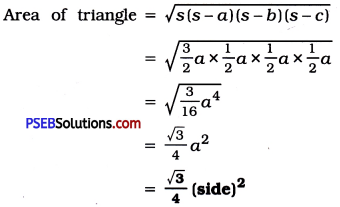
![]()

![]()
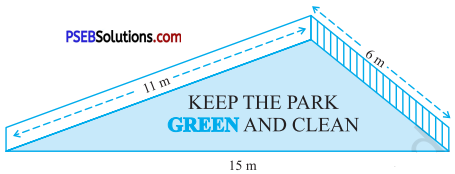
![]()
![]()
![]()
